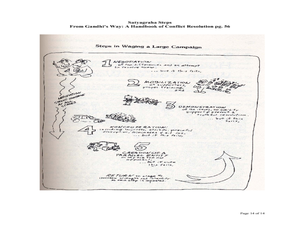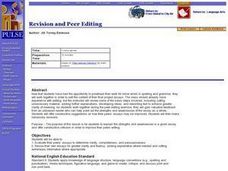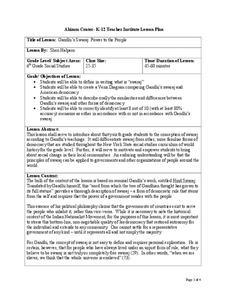Curated OER
Applying Ahimsa to Traditional Stories
Investigate the life of Mahatma Gandhi by researching non-violent lifestyles. Learners define the word ahimsa and discuss the personal characteristics that made Gandhi a peaceful warrior. They also create a poster about the story "The...
Curated OER
Research, Production, and Presentation of Abstract and Pop Art
Students are introduced to Abstract Expressionism and Pop Art using both print materials, Take 5 Art prints and the Illusion4 Palm OS program. They complete a research and art production project that focuses on one artist from the two...
Curated OER
Ahimsa in the Real World: Truth, Love, and Nonviolence
Second graders create an abstract painting that conveys feelings of nonviolence. In this visual arts instructional activity, 2nd graders read "The First Step of Jainism" and discuss honesty, watch a digital story, discuss feelings after...
Curated OER
Gandhi's Non-violent Revolutions: Examining Tools to Make Non-violent
Learners analyze Gandhi's philosophy of nonviolent social change. In this nonviolence and social change lesson, students research a leader from the attached list who practiced nonviolent social change. Learners write their own poem...
Curated OER
Language Arts: Stylistic Devices
Students are able to define given literary terms, such as metaphor, simile, imagery, personification, symbolism, etc. They are able to identify the use of literary elements in a given text. Students are able to interpret weather...
Curated OER
Introduction To Literary Analysis
Explore the fascinating ways in which authors use specific literary devices to create interesting and realistic texts. Using non-fiction articles with the subject of rogue waves, an excerpt from The Perfect Storm, by Sebastian Junger,...
Curated OER
An Introduction to the Season for Nonviolence
Fourth graders create a Venn diagram and a cause and effect graphic organizer on Gandhi and King. In this non violence lesson plan, 4th graders compare the two non violent leaders and discuss and articulate non violent protests and write...
Curated OER
Language Arts: Using Research Tools Successfully
Students are able to record their research observations and reflections by keeping a research journal. They are able to explore a specific region of the world affected by arsenic contamination by using various research skills and tools....
Curated OER
Language Arts: Living in "The Matrix"
Pupils are able to identify, in a discussion mode, the ways in which the media uses persuasion to achieve their desired aims. They analyze, also in a discussion mode, the media's influence on our society by comparing media advertising...
Curated OER
Language Arts: Revision and Peer Editing
Students are able to evaluate their peers' essays to determine clarity, completeness, and persuasiveness. They are able to revise their own essays for greater clarity and fluency, adding explanation where needed and cutting extraneous...
Curated OER
Individual Empowerment in the Face of Oppression
Sixth graders investigate non-violent ways of dealing with conflicts by performing short plays. In this philosophy instructional activity, 6th graders discuss how men can gain power in a non-violent manner similar to Gandhi's actions....
Curated OER
Environmental Health Impromptu Talk
Students learn the criteria for and create the framework of an impromptu speech about an environmental health issue that is especially important to them. Students write a speech about an environmental health problem based on the material...
Curated OER
Language Arts: How Can Research Shape Ideas?
Students are able to characterize arsenic and determine its potential health threats in writing. They are able to compare and contrast arsenic to other water pollutants using Venn diagrams. Students are able to demonstrate essay skills...
Curated OER
Language Arts: Survival Diaries
Students are able to compose a dialectical journal entry which analyzes information presented in a text. They are able to compose a creative journal entry which develops characters, presents events in logical order, and includes sensory...
Curated OER
Comprehension Skills: Evaluate Using Fiction Stories and Aesop's Fables
Primary readers investigate several comprehension skills in the ten lessons of this unit. Forming opinions about stories, comparing stories to each other, using Venn Diagrams, and applying the ideas from a story to real life situations...
Curated OER
Figurative Language
What is figurative language, and why do we use it? Introduce your high schoolers to some examples and discuss the importance of including this element in your writing. After studying a text and searching for examples, writers will...
Curated OER
Gandhi's Voice: Writing as Nonviolent Resistance
Ninth graders identify how Mahatma Gandhi used writing as a means of nonviolent communication. In this nonviolent resistance lesson, 9th graders watch a film about Gandhi as a writer and identify characteristics of nonviolent activism....
Curated OER
Ahimsa in Writers Workshop
Students investigate nonviolent lifestyles by researching the life of Gandhi. In this journalism lesson, students define the word ahimsa and how important nonviolence is when solving conflicts. Students create a timeline of personal...
Curated OER
Tracing the Idea of Civil Disobedience through Thoreau, Gandhi, and King
Students analyze civil disobedience through history studying Thoreau, Gandhi, and Dr. King. In this civil disobedience lesson, students read and analyze excerpts from Thoreau, Gandhi, and Martin Luther King. Students demonstrate their...
Curated OER
Gandhi's Autobiography and the Study of Memoir
Seventh graders explore the life of Gandhi using his autobiography and memoir. In this Gandhi exploration lesson, 7th graders analyze Gandhi's literary voice by reading his autobiography. Students identify literary techniques in Gandhi's...
Curated OER
Chiune Sugihara, Living by Gandhian Principles
Seventh graders read about Chiune Sugihara and analyze the moral situations he faced. In this morality lesson, 7th graders read chapters from A Special Fate, Chiune Sugihara: Hero of the Holocaust and analyze his moral decisions in the...
Curated OER
Gandhi's Swaraj: Power to the People
Sixth graders discover what a swaraj is. In this world history lesson, 6th graders create a Venn Diagram comparing Gandhi's swaraj to American's democracy.
Curated OER
Gandhi's Alternate View of Women: Changing the Face of Modern Media & Advertising
Eleventh graders analyze the violence of media and advertising on women, as well as Gandhi's views of women. In this women and media lesson, 11th graders Killing Us Softly and Tough Guise as an analysis of media and advertising and their...
Curated OER
Gandhi's "Good Life"
Eleventh graders use a Gandhian lens to analyze critically materialism in a capitalist society. In this Gandhian philosophy activity, 11th graders cultivate awareness, explore materialism and sustainability, examine the idea of 'what is...

























